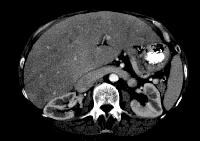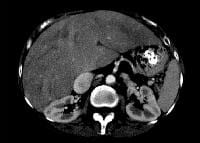Cardiac cirrhosis (congestive hepatopathy) includes a spectrum of hepatic derangements that occur in the setting of right-sided heart failure. Clinically, the signs and symptoms of congestive heart failure (CHF) dominate the disorder. Unlike cirrhosis caused by chronic alcohol use or viral hepatitis, the effect of cardiac cirrhosis on overall prognosis has not been clearly established. As a result, treatment is aimed at managing the underlying heart failure.
Distinguishing cardiac cirrhosis from ischemic hepatitis is important. The latter condition may involve massive hepatocellular necrosis caused by sudden cardiogenic shock or other hemodynamic collapse. Typically, sudden and dramatic serum hepatic transaminase elevations lead to its discovery. Although cardiac cirrhosis and ischemic hepatitis arise from distinct underlying cardiac lesions (right-sided heart failure in the former and left-sided failure in the latter), in clinical practice they may present together.
Despite its name, cardiac cirrhosis (which usually implies congestive hepatopathy that results in liver fibrosis) rarely satisfies strict pathologic criteria for cirrhosis. The terms congestive hepatopathy and chronic passive liver congestion are more accurate, but the name cardiac cirrhosis has become convention. For the remainder of this chapter, the term cardiac cirrhosis will be used to mean congestive hepatopathy with or without liver fibrosis.
 Cardiac cirrhosis. Congestive hepatopathy with large renal vein.
Cardiac cirrhosis. Congestive hepatopathy with large renal vein.  Cardiac cirrhosis. Congestive hepatopathy with large inferior vena cava. NextPathophysiology
Cardiac cirrhosis. Congestive hepatopathy with large inferior vena cava. NextPathophysiologyDecompensated right ventricular or biventricular heart failure causes transmission of elevated right atrial pressure to the liver via the inferior vena cava and hepatic veins. At a cellular level, venous congestion impedes efficient drainage of sinusoidal blood flow into terminal hepatic venules. Sinusoidal stasis results in accumulation of deoxygenated blood, parenchymal atrophy, necrosis, collagen deposition, and, ultimately, fibrosis.
A separate theory proposes that cardiac cirrhosis is not simply a response to chronically increased pressure and sinusoidal stasis. Because intrahepatic vascular lesions are confined to areas of the liver with higher fibrotic burden, cardiac cirrhosis may require a higher grade of vascular obstruction, such as intrahepatic thrombosis, for its development. Thus, thrombosis of sinusoids and terminal hepatic venules propagates to medium-sized hepatic veins and to portal vein branches, resulting in parenchymal extinction and fibrosis.
PreviousNextEpidemiologyFrequencyUnited StatesCardiac cirrhosis rarely occurs in the United States. Its true prevalence is difficult to estimate, since the disease typically remains subclinical and undiagnosed. The incidence of cardiac cirrhosis at autopsy has decreased significantly over the past several decades. This may be due to lower rates of uncorrected rheumatic heart disease and constrictive pericardial disease.
Mortality/MorbidityThe effect of cardiac cirrhosis on mortality and morbidity rates is unknown. The severity of the patient's underlying cardiac disease, which is typically advanced and chronic, is the major determinant of overall outcome.
SexComparative sex data for cardiac cirrhosis do not exist. However, because CHF is more common in men than women in the United States, the same is likely for cardiac cirrhosis.[1]
AgeNo published data exist. However, the prevalence of cardiac cirrhosis in the United States, like that of CHF, almost certainly increases with age.
PreviousProceed to Clinical Presentation , Cardiac Cirrhosis and Congestive Hepatopathy





0 comments:
Post a Comment